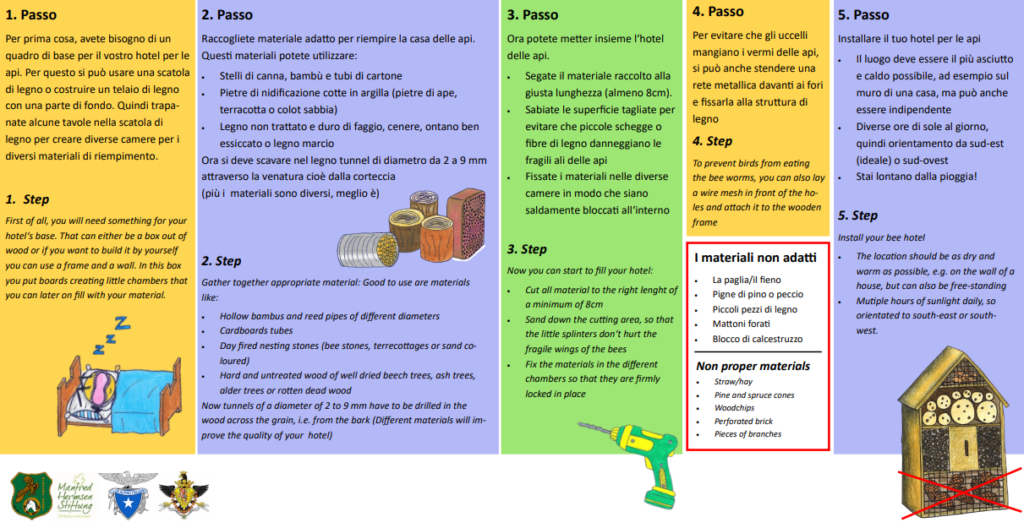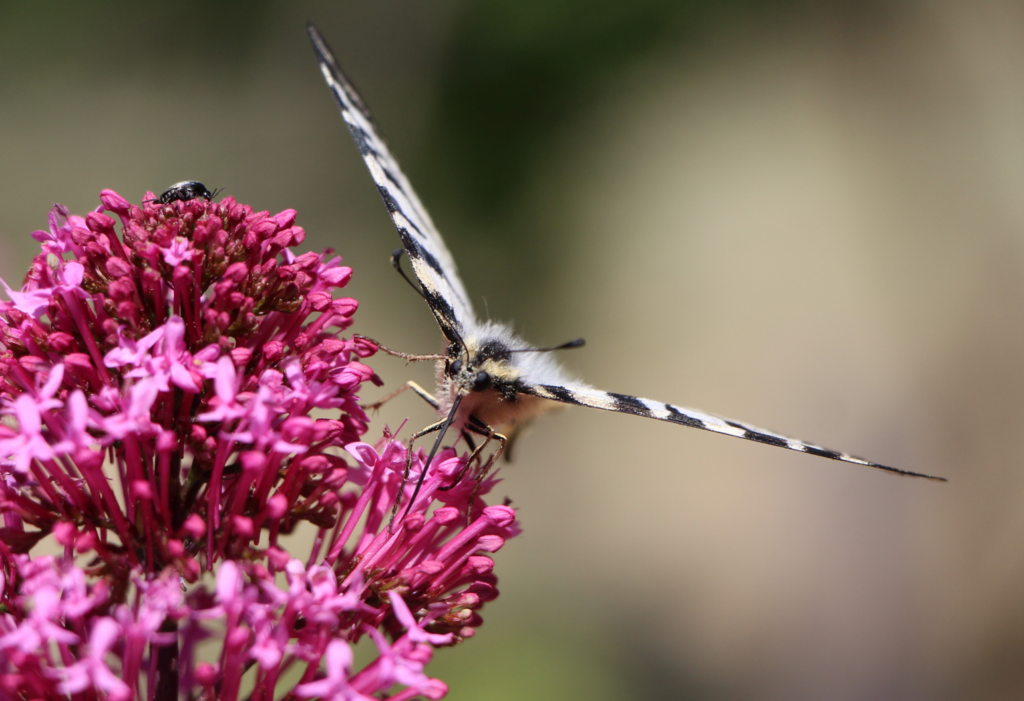Un giardino piacevole per gli insetti
Piante locali di diverse forme di crescita e tempi di fioritura, così come prati incolti ne fanno parte. Gli insetti godono anche di terreni sabbiosi e argillosi, mucchi di legno morto e ghiaia, muri di pietra naturale, gusci di lumache e steli di piante come rifugio.
Oppure si può costruire un hotel per api, per esempio. Potete trovare le istruzioni qui:

Anche le farfalle sono impollinatori?
Le api non sono gli unici insetti impollinatori. Oltre alle api del miele e alle api selvatiche, come i bombi o le api solitarie, anche le mosche, i coleotteri, le falene e talvolta le formiche o i ragni, così come le farfalle, contribuiscono in gran parte all’impollinazione.
In generale, gli impollinatori sono attratti dai fiori dal colore e dall’odore. La lunghezza e la forma dell’apparato boccale dell’insetto, così come la forma e la dimensione del fiore, giocano un ruolo cruciale nel raggiungere il cibo nel fiore.
Le api selvatiche e del miele, per esempio, hanno solo proboscidi corte. Il nettare non dovrebbe quindi essere troppo profondo per loro. Per inciso, sono generalmente attratti soprattutto dai colori giallo e blu.
Le farfalle, invece, possono succhiare il nettare da una profondità fino a quattro centimetri con la loro lunga proboscide. È anche importante che siano in grado di atterrare bene sui fiori. Preferiscono atterrare su fiori rossi, gialli o blu.
Questa diversità di impollinatori è anche importante, perché non tutti gli impollinatori sono adatti ad ogni forma di fiore e quindi ognuno ha le sue preferenze.
Pertanto, è importante offrire agli insetti una grande varietà di piante e, tra le altre cose, rendere il vostro giardino favorevole agli insetti.
Cos’è questo insetto con le ali blu?
Molti di voi probabilmente lo conoscono come il calabrone. In realtà è un’ape, la più grande ape selvatica della regione. Si chiama l’ape legnaiola.
Il calabrone vero e proprio, invece, è un nemico dell’ape. Una volta che cattura un’ape in volo, non ha alcuna possibilità. Ma se si avventura nell’alveare, deve prima passare le api di guardia, che lo riconoscono immediatamente come un nemico. Contrariamente a quanto ci si aspetterebbe, non è respinta da morsi e punture, le api hanno una tattica diversa….
Una massa di api avvolge il calabrone così strettamente che non può scappare. Poi le api aumentano la loro temperatura corporea così tanto che il calabrone muore per surriscaldamento e mancanza di ossigeno, ma loro stessi sopravvivono.
An insect-friendly garden
Native plants of different growth forms and flowering times, as well as unmown meadows are part of this. Insects also enjoy sandy and loamy soils, piles of dead wood and gravel, natural stone walls, snail shells and plant stems as shelter.
Or you can build a bee hotel, for example. You can find instructions here:

Are butterflies also pollinators?
Bees are not the only pollinating insects. In addition to honey bees and wild bees, such as bumble bees or solitary bees, flies, beetles, moths and sometimes ants or spiders, as well as butterflies, also make a large contribution to pollination.
In general, pollinators are attracted to flowers by colour and smell. The length and shape of the insect’s mouthparts, as well as the shape and size of the flower, play a decisive role in reaching food in the flower.
Wild and honey bees, for example, only have short proboscises. The nectar should therefore not be too deep for them. Incidentally, they are generally attracted mainly to the colours yellow and blue.
Butterflies, on the other hand, can suck out nectar from a depth of up to four cm with their long proboscis. It is also important for them to be able to land well on the flowers. They prefer to land on red, yellow or blue flowers.
This diversity of pollinators is also important, because not every pollinator is suitable for every flower shape and so everyone has their preferences.
It is therefore important to offer insects a wide variety of plants and to make your garden insect-friendly.
What is this insect with the blue wings?
In fact, it is a bee, the largest wild bee found here. It is called the violet carpenter bee.
The hornet, on the other hand, is actually an enemy of the bee. Once it has caught a bee in flight, it has no chance. But if it ventures into the hive, it must first pass the guard bees, which immediately recognise it as an enemy. Contrary to what one would expect, she is not repelled by bites and stings, the bees have a different tactic….
A mass of bees envelops the hornet so tightly that it cannot escape. The bees then increase their body temperature so much that the hornet dies from overheating and lack of oxygen, but they themselves just survive.


